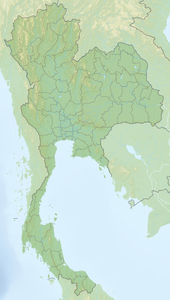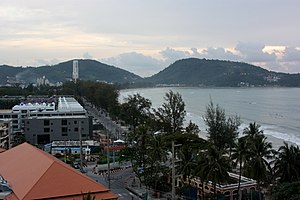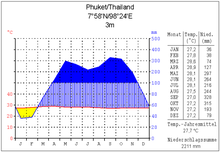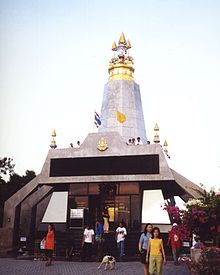Ko Phuket
| Ko Phuket | ||
|---|---|---|
| Phuket as seen from Ko Lon | ||
| Waters | Andaman Sea | |
| Geographical location | 8 ° 0 ′ N , 98 ° 21 ′ E | |
|
|
||
| length | 48 km | |
| width | 19 km | |
| surface | 543 km² | |
| Highest elevation |
Mai Thao Sip Song 529 m |
|
| Residents | 321,802 (2007) 593 inhabitants / km² |
|
| main place | Mueang Phuket | |
| View over Patong / Phuket | ||

Ko Phuket ( Thai เกาะ ภูเก็ต , pronounced [ kɔ̀ʔ pʰuːkèt ], previously also Thalang or Tha-Laang ) is an island in southern Thailand . Together with smaller secondary islands it forms the province of Phuket with the capital of the same name, Phuket .
geography
The island of Phuket is located in the Andaman Sea in the south of Thailand. With a length of about 50 km and a width of about 22 km, it is about 543 km² and thus Thailand's largest island. It is the only island with provincial status ( Changwat ) .
The island is separated from the mainland by a narrow waterway: Captain James Forrest reported in 1784 of a narrow isthmus , about a mile long and half a mile wide, which was only covered by about ten feet of water at high tide.
There are numerous sandy beaches on the west coast, one of which, Patong Beach, was, according to Captain Alexander Hamilton's record, an excellent haven for sailing ships during the northeast monsoons at the beginning of the 18th century . Today many beaches are the destination of tourist package vacationers from all over the world.
The interior of the island was previously covered by dense jungle , which was home to a diverse fauna . The Danish biologist Dr. In 1779 Koenig reported that on his “botanical excursions” he had to run away from wild elephants and that tigers decimated the live supplies of goats in his camp. He reported on the rhinoceros , whose horn was a popular and expensive commodity. Today there are only a few places where a jungle can grow, such as B. in the national park on the northern tip of the island. Mainly, however, the island is overgrown with coconut palms today , there are also some rubber plantations, pineapples and bananas are grown.
origin of the name
On old nautical charts since the 13th century the island is called Junkceylon , probably a corruption of the Malay Ujong Salan , which means "Cape Salang" ("Junkceylon" has nothing to do with Chinese junks or the island of Ceylon ). On Portuguese maps the Portuguese spelling is Iunsalão , yet another spelling is Jonkcelaon .
The locals called their island Chalang ( ฉลาง ) in ancient times , later it also appears as Thalang ( ถลาง ) in Siamese documents. The name “Phuket” ( ภู เก็จ ) used to be the name of the southernmost district of the island, which is probably only coincidentally similar to the Malay Bukit ( hill ).
It was not until the end of the 19th century that the name of the island changed from Junkceylon or Thalang to the current name "Phuket".
History and population
According to legend, the Egyptian geographer Ptolemy was already on Phuket in the 1st century. There is evidence that the island is mentioned for the first time around 1200 in the Kedah annals of Malaysia.
The indigenous population of the island belongs to the Urak Lawoi , Moken and Moklen peoples , who are grouped together as " sea nomads ". The first settlers on the island were people of the Mon ethnic group , who immigrated from what is now Myanmar before Sukhothai . After the takeover by Ayutthaya , King Ekathotsarot allowed Europeans to trade here for the first time; initially the Portuguese set up branches. Its architectural influence can still be felt today. Lured by the abundance of tin, the Chinese came to Phuket in the 19th century . Since the immigrants were mostly single men, they married local Thai women. Their descendants identified themselves neither as Chinese nor as Thai, but developed their own ethnic identity and cultural tradition as Baba (also known as Peranakan). Instead of miners, many of them soon worked as merchants and founded the island capital , which quickly became a flourishing trading town. The Baba also have their own cuisine, which combines Chinese and southern Thai influences. Particularly noteworthy are the desserts. Customs like the Moon Festival and the “Vegetarian Festival” go back to this legacy.
Many residents are also ethnic Malays , so the Islamic influence can also be felt (25% of the population of Phuket are Muslims). Other noteworthy population groups are Sikhs who have immigrated from India , as well as, especially in recent times, immigrants from western nations.
In 1933, Phuket City was declared the provincial capital.
On December 26, 2004, a devastating tsunami struck Phuket, killing the entire region. The origin was a strong earthquake in the Indian Ocean off the northwest coast of Sumatra . In the area of Kata and Karon and south of them, only a few effects of the tsunami can be seen in May 2005, and since the winter season 2005/2006 there are hardly any traces of the disaster on the other beaches.
A majority of the Thais who work in the tourist centers of the island are not native to Phuket, but come from other, economically weaker regions of Thailand. Increasingly, workers from the even poorer neighboring countries of Myanmar , Laos and Cambodia are also migrating here. Patong, the tourist stronghold, is now the most expensive place in all of Thailand.
Economical meaning
- Mining : formerly tin and tungsten (completely discontinued since 2005)
- Agriculture : copra ( coconut meat ) and rubber plantations
- Fishing and pearl farming
- since 1980 mass tourism
climate
| Ko Phuket | ||||||||||||||||||||||||||||||||||||
|---|---|---|---|---|---|---|---|---|---|---|---|---|---|---|---|---|---|---|---|---|---|---|---|---|---|---|---|---|---|---|---|---|---|---|---|---|
| Climate diagram | ||||||||||||||||||||||||||||||||||||
| ||||||||||||||||||||||||||||||||||||
|
Average monthly temperatures and rainfall for Ko Phuket
Source: missing
|
||||||||||||||||||||||||||||||||||||||||||||||||||||||||||||||||||||||||||||||||||||||||||||||||||||||||||||||||||||||||||||||||||||||||||||||||||||||||||||||||||||||||||||||||||||||||||||||||||||||||||||||||||
Airport
Phuket has an international airport located 32 km from the capital in the northern part of the island in the Thalang district . It is now the airport with the third most passengers in Thailand. According to official information, another terminal should be opened at the beginning of 2016 and the airport should increase its capacity to 12.5 million passengers per year. Thai Airways has been offering direct flights from Frankfurt since May 2016.
Regular events
The triathlon , initiated in 1994 by IMG , the world's largest sports marketer, on Phuket is one of the most traditional and important triathlon events in Asia and takes place every year at the end of November and beginning of December as the Challenge Laguna Phuket Tri Fest .
In late September or October each year, Phuket celebrates the nine -day festival of the nine emperor gods , commonly known as the "Vegetarian Festival" (Thesakan Kin Che) . Its most noticeable features for outsiders are the renunciation of animal food as well as processions with people who put themselves into a trance as spirit media and castigate themselves as proof of their supposed invulnerability, for example by piercing their cheeks with sharp objects.
Attractions
- Put Yaw, a 200 year old temple used by Chinese immigrants in Phuket City
- Wat Chalong , Buddhist temple ( wat ) in the southwest of the island. Its former abbot (Luang Pho Chaem) is still very revered today. Hundreds of tourists from Thailand, China, Taiwan etc. arrive every day.
- Laem Phrompthep, the southernmost tip ( cape ) of the island with a view of the sea and offshore small islands, meeting point (not only) for Thai tourists to watch the sunset
- 3 Bay View Point, located in the south of Kata on the beach road towards Laem Phrompthep, "postcard view" of the three beaches of Kata Yai, Kata Noi and Karon
- Ko Raya Archipelago , two small islands, about 45 minutes by boat from Chalong Bay.
- Big Buddha, a large Buddha statue on the Nakkerd Hills overlooking Phuket City , Kata, Karon and Chalong
- Sirinat National Park, in the north of the island you can still find some jungle.
- Beaches: Nai Thon Beach, Kamala Beach, Patong Beach, Karon Beach, Kata Yai Beach.
literature
- Colonel GE Gerini: Historical Retrospect of Junkceylon Island. Bangkok 1905. In: Selected Articles from The Siam Society Journal , Vol. IV. Bangkok 1959.
- The Siam Society : Old Phuket. Bangkok 1986, ISBN 974-8298-07-8 . (Illustrated reprint of the above article expanded by 2 more articles). Original article published in: Journal of the Siam Society, 2 (1904), no.2 , online siamese-heritage.org (PDF; 20.2 MB), accessed October 31, 2012.









